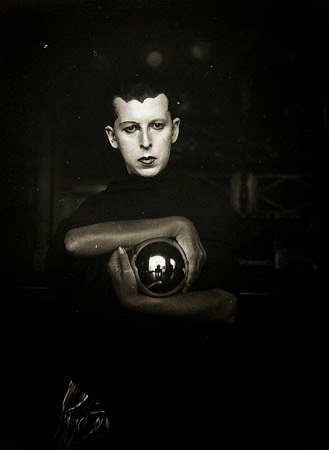Female surrealists took advantage of the socio-political
and economic climate and travelled down the road of self-exploration becoming
the first modernist movement in which a group of women could explore female
subjectivity and give form to a feminine imagination.”
Traditionally, portraiture has represented women as passive muses or erotic objects. This was strongly evident in art by the male surrealists who tended to paint women as either spiritual or magical beings, sexualised characters, or more often than not, passive muses with no voice of their own
The female surrealists developed strategies to present identity as something that is not fixed, but is transformative and continually changing and they explored this through their own sub-consciousness and dreams.
Lets have a look at these inspiring women
Claude Cahun 1894-1954
Photography, Sculpture, Collage
Identified as agender
She challenged the perception of binary gender norms personally, politically and throughout her work
What particularly draws me to the work and life of Claude Cahun is how she made art that was both sensually arousing and attractive as well as politically committed .
Cahun’s work ranged from photographs (often self-portraits in various states of dress and undress), sculputors/objects aligned to surrealism, to more overtly political constructions and activism.
Her work is often playful and theatrical. Her make-up skills are quite something to behold.
An obvious charm about her work was her ability to take her self seriously through a creative exploration of identity, perceptions and cultural norms
Don't Kiss Me I'm in Training 1927
Self-Portrait, Silver gelatin print on paper, 1929


Cahun showed a remarkable ability for gender transformation. She holds mysterious props that turn her into a magician, a doll, or an impenetrably masked androgyny. With her hooked nose and a shaved head, it seems she could photograph herself as male, female, or any shade in between
Frida Khalo 1907-1954
PainterHer work is celebrated for her uncompromising depiction of the female experience and form.Kahlo’s body and her cultural identity(ies) are central to an understanding of her work.
Her work often depicts intense emotional and physical pain.
Kahlo turned herself and her own individual feminine obsessions and dilemmas into subject matter.
Along the way she challenged the contemporary perceptions of female beauty. She is often remembered for celebrating female facial hair.
“I paint myself because I am so often alone and because I am the subject I know best”
Roots, 1943, Frida stated her faith that all life can join in a single flow. In this painting, Frida is depicted as her torso opens up like a window and gives birth to a vine. It's her dream of being able to give birth as a childless woman. Frida's blood circulates the vine and reach beyond the leaves' veins and feed the parched earth. She is dreaming to be a tree of life with her elbow supporting her head on a pillow.
This painting was completed shortly after her divorce with Diego RivieraThis portrait shows Frida's two different personalities. -the traditional Frida in Tehuana costume, with a broken heart, sitting next to an independent, modern dressed Frida. She admitted it expressed her desperation in the loneliness from separating from Diego.
Frida used a young deer with the head of herself and was fatally wounded by a bunch of arrows. The background is the forest with dead trees and broken branches, implying the feeling of fear and desperation. Far away is the stormy, lightning-lit sky which brings some hope but the dear will never be able to reach it.
Louise Bourgeois (1911-2010)
Sculptor. painter, installation artist.
Her work shared a set of repeated themes, centred on the human body and its
need for nurture and protection in a frightening world
She worked with the unconscious, sexual desire, and the body, drawing on events from her childhood.
She considered making art a therapeutic or cathartic process.
Influences include: Mythological and archetypal imagery, objects such as spirals, spiders, cages, medical tools, and sewn appendages; symbolizing the feminine psyche, beauty, and psychological pain.
She dealt with notions of universal balance, playfully juxtaposing materials conventionally considered male or female. She has described her work as dealing with problems that are pre(post)-gender, citing jealousy as an example.
Spiral women 2001
The reticent child 1998
Untitled 1996


















